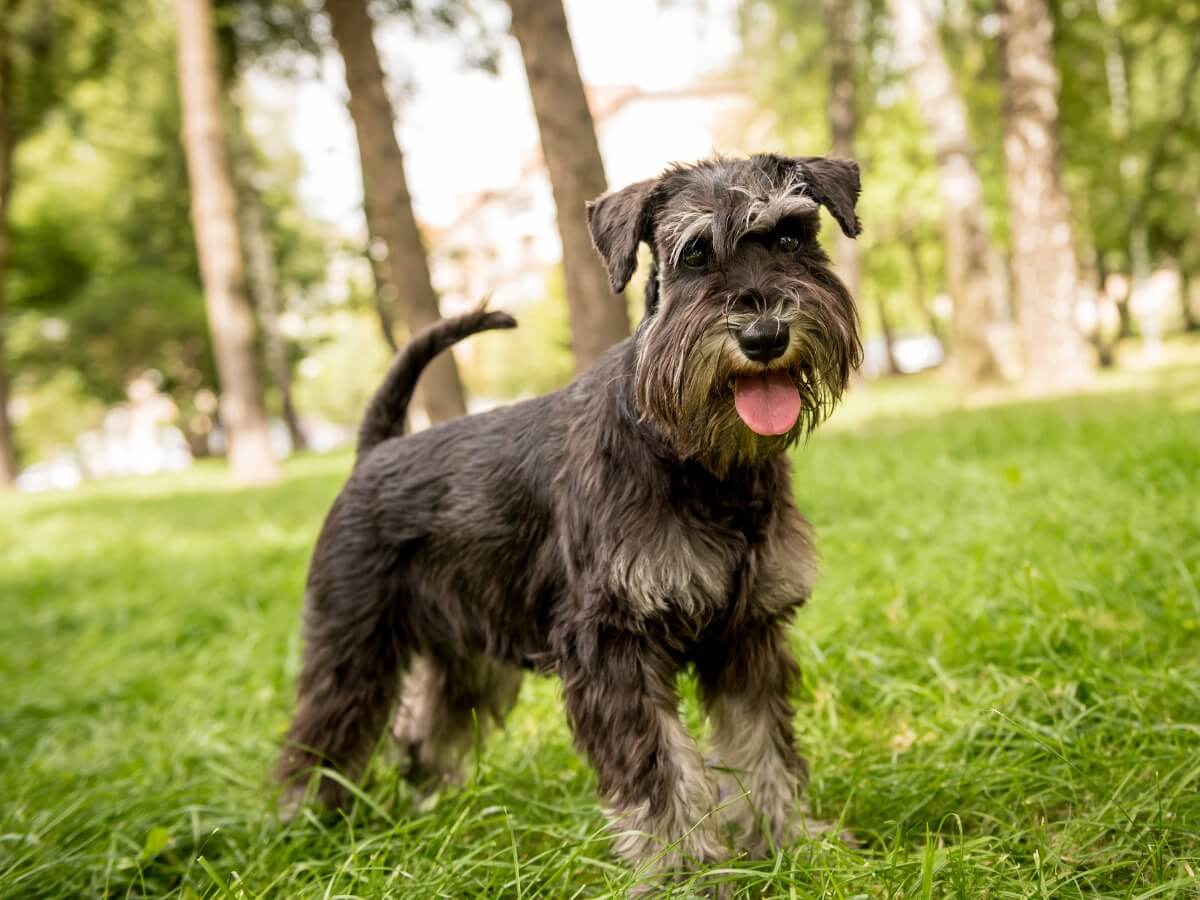Tips for Looking After Your Miniature Schnauzer


Reviewed and approved by the biologist Samuel Sanchez
The miniature schnauzer is a small dog breed that’s part of the three existing variants of the schnauzer, along with the standard and the giant. This dog is recognized for being able to adapt quickly to living in small spaces and it provides a lot of versatility when it comes to home and maintenance.
However, people who adopt a dog of this type must take into account certain care tips for the miniature schnauzer so that it can develop as a healthy and happy dog at home. Here we’ll tell you everything you need to know about this breed and its peculiarities.
Characteristics of the miniature schnauzer
This canine measures 30 to 35 centimeters (12 to 14 inches) and can weigh from 4 to 8 kilos (about 8 to 16 pounds). In addition, it has a representative beard around its muzzle, which forms thanks to its abundant fur. According to the International Cynological Federation, miniature schnauzers can be pure black with a black and silver undercoat, or pure white with a white undercoat.
In the same way, the miniature schnauzer is characterized by having a rectangular head, bent and drooping ears and an elegant, robust and muscular demeanor. On the other hand, in terms of their temperament, this breed is affectionate and protective. It’s also an easy learner and can be loyal company in the long run.
Miniature schnauzer care
Like any other pet, the miniature schnauzer needs a lot of attention and certain attention, taking into account the dog’s characteristics. For those who have a dog of this type, or who plan to have one at home, the 7 tips to care for your miniature schnauzer that we have for you today will surely be of great help.
1. Vaccination and professional check-ups
It’s important that, as a first step, you take your miniature schnauzer to a veterinarian for a check-up to determine if it has any special conditions that should be seen to. In addition, you need to ensure that this small dog breed has all its mandatory vaccinations.
It’s also wise to visit your vet several times a year to have your miniature schnauzer’s development evaluated. The objective of these routine check-ups is to prevent diseases that may affect not only the canine, but also the people who live with it.
As a minimum, an adult dog should go to the vet for a general check-up once a year.

2. Create a routine
The miniature schnauzer is very intelligent and can become a fairly obedient dog if you start to train it from when it’s a puppy, or from the day it becomes part of your home. However, you shouldn’t be too rigid with the rules you set, to ensure that your little dog doesn’t feel frustrated or pressured.
Giving a lot of affection and using treats are ways to encourage the miniature schnauzer to adapt more easily to its routines for eating, walking, going to the toilet, and resting. If you manage to educate them during the first 20 weeks of their life, it will be much easier for this dog to become a loving, happy, intelligent and obedient companion.
3. Food care
When looking after your miniature schnauzer, a balanced diet is a fundamental point, as these little dogs have a fast metabolism and tend to eat too much if limits aren’t established. If not treated with care, the miniature schnauzer could suffer from obesity problems, especially if they don’t get enough exercise.
It’s advisable to feed this little canine about three times a day. However, when doing so, remember to be prudent with the size of these servings. Also, consulting with a veterinarian can make it easier for you to find a diet suitable for the miniature schnauzer.
4. Exercise
Physical activity is important in order to create balance in the miniature schnauzer’s life. Therefore, it’s essential that you encourage it (and yourself!) to go for a daily walk and also to run around the house, in order to keep its body and muscles healthy.
In this sense, using a ball to play with your miniature schnauzer or creating small obstacles that the dog can jump are ways to get this little one to exercise and enjoy the process. Don’t forget about their mental stimulation. Olfactory games, for example, are an excellent idea that go beyond mere muscle exercise.
5. Grooming and brushing
As part of caring for your miniature schnauzer, it’s advisable to take the dog to a stylist to cut its hair, as this dog is a breed that doesn’t shed its fur. So if you don’t any have experience cutting your pet’s hair, it’s best to let someone who really knows do it.
On the other hand, you’ll need to get your miniature schnauzer used to having its hair brushed, at least 3 times a week. This is the only way to prevent knots in its coat and keep it looking good. In the same way, don’t forget that bathing is important, as long as it isn’t too frequent, as this could cause skin diseases. Bathing them once a month is a good option.
6. Health
Although their life expectancy is between 10 and 14 years, you should pay close attention to the miniature schnauzer’s health. This small dog breed can suffer from liver problems, dental disease, eye failure, skin complications, and other syndromes.
On the other hand, according to the Argentine Veterinary Journal, a study shows that miniature schnauzers are particularly prone to infections by certain mycobacteria. These could end up being transmitted to their owners, especially if they’re immunosuppressed patients or undergoing chemotherapy treatment.
It’s important that, as part of caring for a miniature schnauzer, the people in charge of this small dog go to the veterinarian to take a check on the health of their pet. This becomes more essential if the dog begins to feel uncomfortable or exhibits major changes in its behavior.
7. Behavior
Finally, it should be noted that the miniature schnauzer is a dog that’s always alert and has a lot of energy. It’s also an excellent guardian and a faithful companion for the whole family.
However, it’s also a dog recognized for its fearlessness. It’s necessary to allow them to socialize with people, animals and their environment in general, in order to make them feel calm within the family nucleus.

Finally, taking into account these tips to look after your miniature schnauzer will help the little canine to lead a healthy life and acquire habits suitable for its development. In addition to this, check-ups by a veterinarian will be fundamental in the life of this loving and brave dog.
The miniature schnauzer is a small dog breed that’s part of the three existing variants of the schnauzer, along with the standard and the giant. This dog is recognized for being able to adapt quickly to living in small spaces and it provides a lot of versatility when it comes to home and maintenance.
However, people who adopt a dog of this type must take into account certain care tips for the miniature schnauzer so that it can develop as a healthy and happy dog at home. Here we’ll tell you everything you need to know about this breed and its peculiarities.
Characteristics of the miniature schnauzer
This canine measures 30 to 35 centimeters (12 to 14 inches) and can weigh from 4 to 8 kilos (about 8 to 16 pounds). In addition, it has a representative beard around its muzzle, which forms thanks to its abundant fur. According to the International Cynological Federation, miniature schnauzers can be pure black with a black and silver undercoat, or pure white with a white undercoat.
In the same way, the miniature schnauzer is characterized by having a rectangular head, bent and drooping ears and an elegant, robust and muscular demeanor. On the other hand, in terms of their temperament, this breed is affectionate and protective. It’s also an easy learner and can be loyal company in the long run.
Miniature schnauzer care
Like any other pet, the miniature schnauzer needs a lot of attention and certain attention, taking into account the dog’s characteristics. For those who have a dog of this type, or who plan to have one at home, the 7 tips to care for your miniature schnauzer that we have for you today will surely be of great help.
1. Vaccination and professional check-ups
It’s important that, as a first step, you take your miniature schnauzer to a veterinarian for a check-up to determine if it has any special conditions that should be seen to. In addition, you need to ensure that this small dog breed has all its mandatory vaccinations.
It’s also wise to visit your vet several times a year to have your miniature schnauzer’s development evaluated. The objective of these routine check-ups is to prevent diseases that may affect not only the canine, but also the people who live with it.
As a minimum, an adult dog should go to the vet for a general check-up once a year.

2. Create a routine
The miniature schnauzer is very intelligent and can become a fairly obedient dog if you start to train it from when it’s a puppy, or from the day it becomes part of your home. However, you shouldn’t be too rigid with the rules you set, to ensure that your little dog doesn’t feel frustrated or pressured.
Giving a lot of affection and using treats are ways to encourage the miniature schnauzer to adapt more easily to its routines for eating, walking, going to the toilet, and resting. If you manage to educate them during the first 20 weeks of their life, it will be much easier for this dog to become a loving, happy, intelligent and obedient companion.
3. Food care
When looking after your miniature schnauzer, a balanced diet is a fundamental point, as these little dogs have a fast metabolism and tend to eat too much if limits aren’t established. If not treated with care, the miniature schnauzer could suffer from obesity problems, especially if they don’t get enough exercise.
It’s advisable to feed this little canine about three times a day. However, when doing so, remember to be prudent with the size of these servings. Also, consulting with a veterinarian can make it easier for you to find a diet suitable for the miniature schnauzer.
4. Exercise
Physical activity is important in order to create balance in the miniature schnauzer’s life. Therefore, it’s essential that you encourage it (and yourself!) to go for a daily walk and also to run around the house, in order to keep its body and muscles healthy.
In this sense, using a ball to play with your miniature schnauzer or creating small obstacles that the dog can jump are ways to get this little one to exercise and enjoy the process. Don’t forget about their mental stimulation. Olfactory games, for example, are an excellent idea that go beyond mere muscle exercise.
5. Grooming and brushing
As part of caring for your miniature schnauzer, it’s advisable to take the dog to a stylist to cut its hair, as this dog is a breed that doesn’t shed its fur. So if you don’t any have experience cutting your pet’s hair, it’s best to let someone who really knows do it.
On the other hand, you’ll need to get your miniature schnauzer used to having its hair brushed, at least 3 times a week. This is the only way to prevent knots in its coat and keep it looking good. In the same way, don’t forget that bathing is important, as long as it isn’t too frequent, as this could cause skin diseases. Bathing them once a month is a good option.
6. Health
Although their life expectancy is between 10 and 14 years, you should pay close attention to the miniature schnauzer’s health. This small dog breed can suffer from liver problems, dental disease, eye failure, skin complications, and other syndromes.
On the other hand, according to the Argentine Veterinary Journal, a study shows that miniature schnauzers are particularly prone to infections by certain mycobacteria. These could end up being transmitted to their owners, especially if they’re immunosuppressed patients or undergoing chemotherapy treatment.
It’s important that, as part of caring for a miniature schnauzer, the people in charge of this small dog go to the veterinarian to take a check on the health of their pet. This becomes more essential if the dog begins to feel uncomfortable or exhibits major changes in its behavior.
7. Behavior
Finally, it should be noted that the miniature schnauzer is a dog that’s always alert and has a lot of energy. It’s also an excellent guardian and a faithful companion for the whole family.
However, it’s also a dog recognized for its fearlessness. It’s necessary to allow them to socialize with people, animals and their environment in general, in order to make them feel calm within the family nucleus.

Finally, taking into account these tips to look after your miniature schnauzer will help the little canine to lead a healthy life and acquire habits suitable for its development. In addition to this, check-ups by a veterinarian will be fundamental in the life of this loving and brave dog.
All cited sources were thoroughly reviewed by our team to ensure their quality, reliability, currency, and validity. The bibliography of this article was considered reliable and of academic or scientific accuracy.
- Schnauezer miniatura. Federación Cinológica Internacional. Recogido el 12 de julio de 2021 de: http://www.fci.be/nomenclature/standards/183g02-es.pdf
- Alertan sobre una enfermedad que afecta a los Schnauzer miniatura. Revista Veterinaria Argentina. Recogido el 12 de julio de 2021 de: https://www.veterinariargentina.com/revista/2017/09/alertan-sobre-una-enfermedad-que-afecta-a-los-schnauzer-miniatura/?hilite=%27Schnauzer%27
This text is provided for informational purposes only and does not replace consultation with a professional. If in doubt, consult your specialist.








